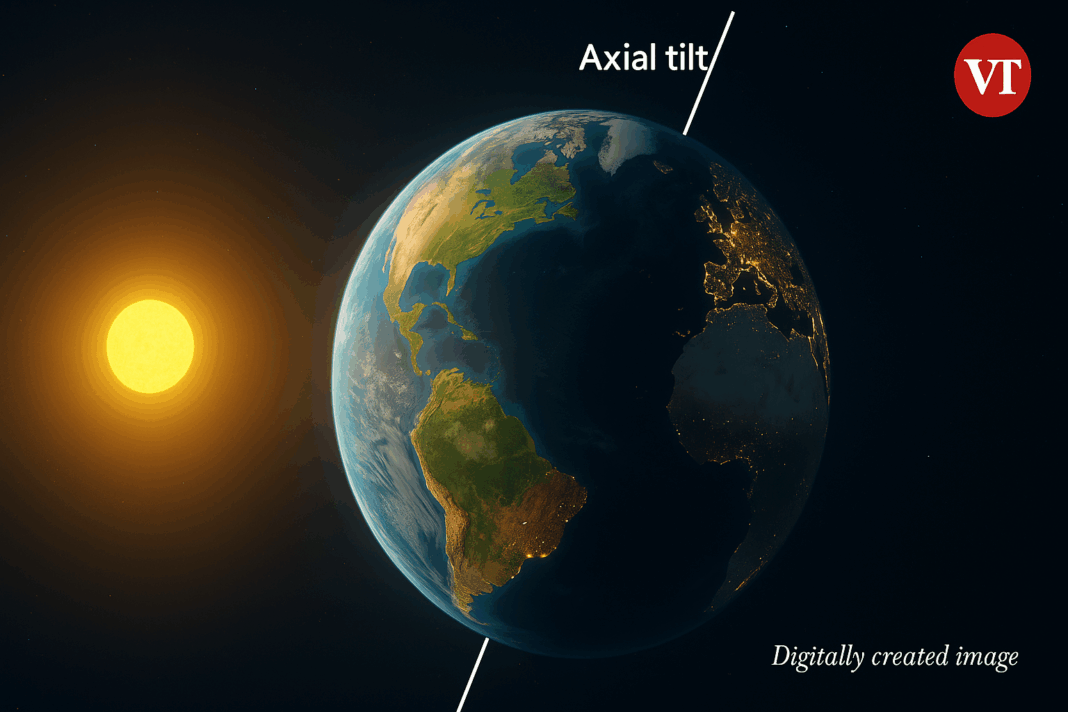- • Earth’s tilt, not its distance from the Sun, causes seasons.
- • When the North Pole tilts toward the Sun, it’s summer in the Northern Hemisphere.
- • Earth is actually closest to the Sun during Northern Hemisphere winter.
Have you ever wondered why the Earth experiences seasons? While many believe that our planet’s distance from the Sun determines whether it’s summer or winter, the real reason lies in the Earth’s axial tilt. According to timeanddate.com, it’s the angle at which Earth orbits the Sun—known as obliquity—that explains the changing seasons across the globe.
The Tilt That Changes Everything
The Earth’s axis is tilted at approximately 23.5 degrees. Because of this slant, different regions of the planet receive varying amounts of sunlight throughout the year. Around the June solstice, the North Pole leans toward the Sun, bathing the Northern Hemisphere in more direct sunlight—resulting in summer. At the same time, the Southern Hemisphere tilts away, experiencing winter. This situation reverses during the December solstice, when summer arrives in the South and winter grips the North.
Opposite Seasons Explained
This axial tilt is why seasons are opposite in the two hemispheres. When it’s summer in New York, it’s winter in Sydney. From June through August, the Northern Hemisphere receives longer days and stronger sunlight. In contrast, the Southern Hemisphere gets its summer during December through February, when the South Pole leans toward the Sun.
Always Pointing the Same Way
Interestingly, Earth’s tilt direction doesn’t significantly shift throughout the year. Instead, it’s our planet’s position in its orbit around the Sun that changes. This means the same hemisphere always points in the same general direction in space, but as we move around the Sun, the hemisphere facing the Sun changes—thus creating seasonal variation.
The Orbit Myth
Contrary to popular belief, seasons are not caused by how close Earth is to the Sun. As explained by timeanddate.com, our planet follows an elliptical path—not a perfect circle—around the Sun. Yet this elliptical shape has minimal impact on temperature. Earth is actually closest to the Sun (perihelion) in early January and farthest (aphelion) in early July. This clearly disproves the idea that proximity to the Sun brings warmth.
Small Differences in Energy
Although the Earth receives slightly more solar energy when it’s near perihelion, the temperature difference between hemispheres is relatively small. That’s because the Southern Hemisphere is covered mostly by oceans, which take longer to heat up than landmasses in the Northern Hemisphere. Thus, the tilt remains the dominant factor behind the changing seasons, not the orbital distance.
📚 Scientific Backing and Research
Leading scientific organizations confirm the core role of axial tilt in seasonal change:
- NASA: “It’s Earth’s tilt that causes the seasons. Earth’s axis is always tilted at an angle of about 23.5 degrees.” — NASA Climate Kids
- NOAA: Earth reaches perihelion (~147 million km from the Sun) around January 3 and aphelion (~152 million km) around July 4. Yet, seasons in the Northern Hemisphere follow the opposite pattern — proving distance is not the cause. — NOAA Education
- AGU (American Geophysical Union): Their peer-reviewed research shows Earth’s solar insolation (sunlight energy) patterns are overwhelmingly shaped by tilt, not orbital eccentricity. — AGU Earth & Space Science
- Milankovitch Cycles: Over long timeframes, shifts in axial tilt and orbit contribute to global climate cycles like ice ages. These natural cycles demonstrate how axial tilt influences Earth’s solar exposure. — NASA Earth Observatory
Final Thoughts
Understanding how Earth’s tilt—not its proximity to the Sun—causes the seasons corrects one of the most widespread misconceptions in science education. This tilt governs our climate, agricultural patterns, and even cultural traditions tied to solstices and equinoxes. The science is settled—and it’s all about the angle.
Follow Virginia Times for regular news updates. Stay informed with the latest headlines, breaking stories, and in-depth reporting from around the world.
A global media for the latest news, entertainment, music fashion, and more.















